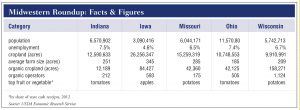Like Piazza, Robert Kirch, president and CEO of Indianapolis-based Caito Foods Service Inc. enjoys the company’s central location and reach not only for reduced freight costs, but for environmental costs as well. “The biggest benefit of sourcing regionally,” he notes, “is the ability to reduce our carbon footprint. It also has a financial impact since we can backhaul most of the product we source from the Midwest.”
Kerry Byrne, executive vice president of Total Quality Logistics, a non-asset based freight brokerage headquartered in Cincinnati, puts it this way: “We’re a day’s drive from more than half of the U.S. population. Thousands of customers and carriers with whom we do business are also located in the Midwest.” Even with terminal markets in St. Louis, Columbus, and Cleveland, companies can go to Chicago and Detroit in just a few hours as needed, or even south.
Western Missouri Fruit Sales, located in Waverley, MO, sends a substantial amount of fruit down south, still within easy reach of the company. “We specialize in apples and pears,” says Matt Blomberg in sales, “a lot of our product is shipped to Texas and Louisiana.”
Trends Spur Regional Growth
While most Midwest states have experienced modest population growth since 2010, the economy is affected by the expanding gas and oil industry in nearby North and South Dakota. Maglio says, “Much of the ‘Rust Belt’ has been stagnant in terms of population growth. However, the petroleum boom in the North Dakota area has brought many new inhabitants looking for jobs.”
Jobseekers mean more food buyers, including fruits and vegetables, though at varying levels according to Maglio, who believes many older workers, Baby Boomers, have more “basic tastes—meat and potatoes” while the younger generations, Generation X and millennials, are “heading towards a fresher food path.”
Further, Maglio explains, “The variety of fresh herbs and unusual flavors are driving the cooking boom.” One such example is lemons: “Meyer lemons are now common in most produce departments,’ he says, “they were virtually unheard of five years ago. And ginger has jumped out of the background as an ingredient for juicing operators.”


Loco for Locally Grown
The interest in sourcing local produce remains a growth factor in the Midwest. According to a Wisconsin Public Radio story, in rural Vernon County, WI, farmers sold almost $2.7 million worth of products directly to consumers—nearly twice as much as in 2007.



